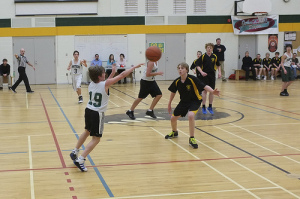Advancing the Ball out of the Backcourt with Speed

The Backcourt is the no-man’s land for an offense. Scoring passes very rarely originate from this area and if anything, this area of the court serves more as a heightened place of anxiety and nerves. Being stuck in the backcourt for a player without a clear idea of what to do is a recipe for disaster.
To try and overcome some of the more common issues faced when moving the ball up the floor a couple key points have been highlighted. These are explained below:

Spacing
One of the common problems seen in the backcourt is spacing. Poor spacing has a number of draw backs for the offense. The results of which are that it takes more passes, more players, and more time to move a ball up the floor and across halfway.
While being too far apart can also provide issues, the optimum range should be somewhere between ten and fifteen feet depending on the age, strength and competence of players.
Full court trapping is one of the more challenging situations to be faced by players. When this happens spacing is often the one characteristic the defence detests the most. Good spacing means for the defence that there are always gaps, the seams in the defence become bigger and if beaten, the help defence takes longer to come into play.
Receivers and Runners
When an offense is trying to advance a ball up the court, the fastest way to do so is through passing the ball, not dribbling. The fleetest of foot Point Guard will always be beaten by a well-executed transition (if not, then you might need to look at your transition). To be effective though at any point within the progression of the ball there must be both receivers and runners involved.
Receivers are targets for the ball handler to pass to. Runners are those players primarily concerned with creating space and advancing to furthest position of an offensive individual down the floor. Both positions are equally important, and if the wrong balance is employed within a team’s transition or press breaker then the chances of a poor outcome increase.
If a team’s looks to bring too many receivers to the ball then they will inevitably slow, and in some cases stall the ability of the offense to push the ball ahead quickly. If not enough receivers present to the ball then too much work can be left for the ball handler to do. To help with this a simple rule of thumb can be applied. Whenever the ball is caught by an offensive player, there should be two receivers at any one time acting as possible targets. With the other two players acting as runners and stretching the defence further and further.
One lesson to be taught to players is the risk in passing across the split line in transition or traffic. Too many times players look for this pass and see the target without the impending dangers when attempting this type of pass. Passing across the split line and up the floor often lengthens the distance the ball must travel. This will result in the ball being in the air for longer and make the pass slower. Additionally, because of the angle of the pass, being able to judge the position of defenders relevant to the target becomes very difficult. It is not easy, even for experienced players to be able to judge this well. A turnover in the backcourt often leads to an immediate scoring opportunity so the pressure to make the right choice is higher.
Often the simplest rules are the best for solving problems within sports because they don’t reply on complicated steps and actions to be performed by individuals on the court during pressure situations. Look to a team’s spacing, receivers and runners when trying to advance the ball out of the backcourt and you will probably identify a large percentage of problems.

